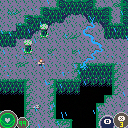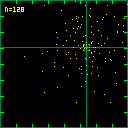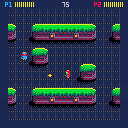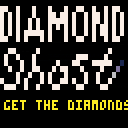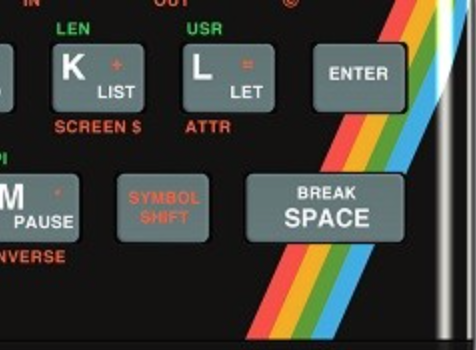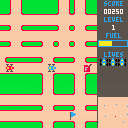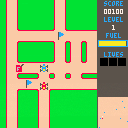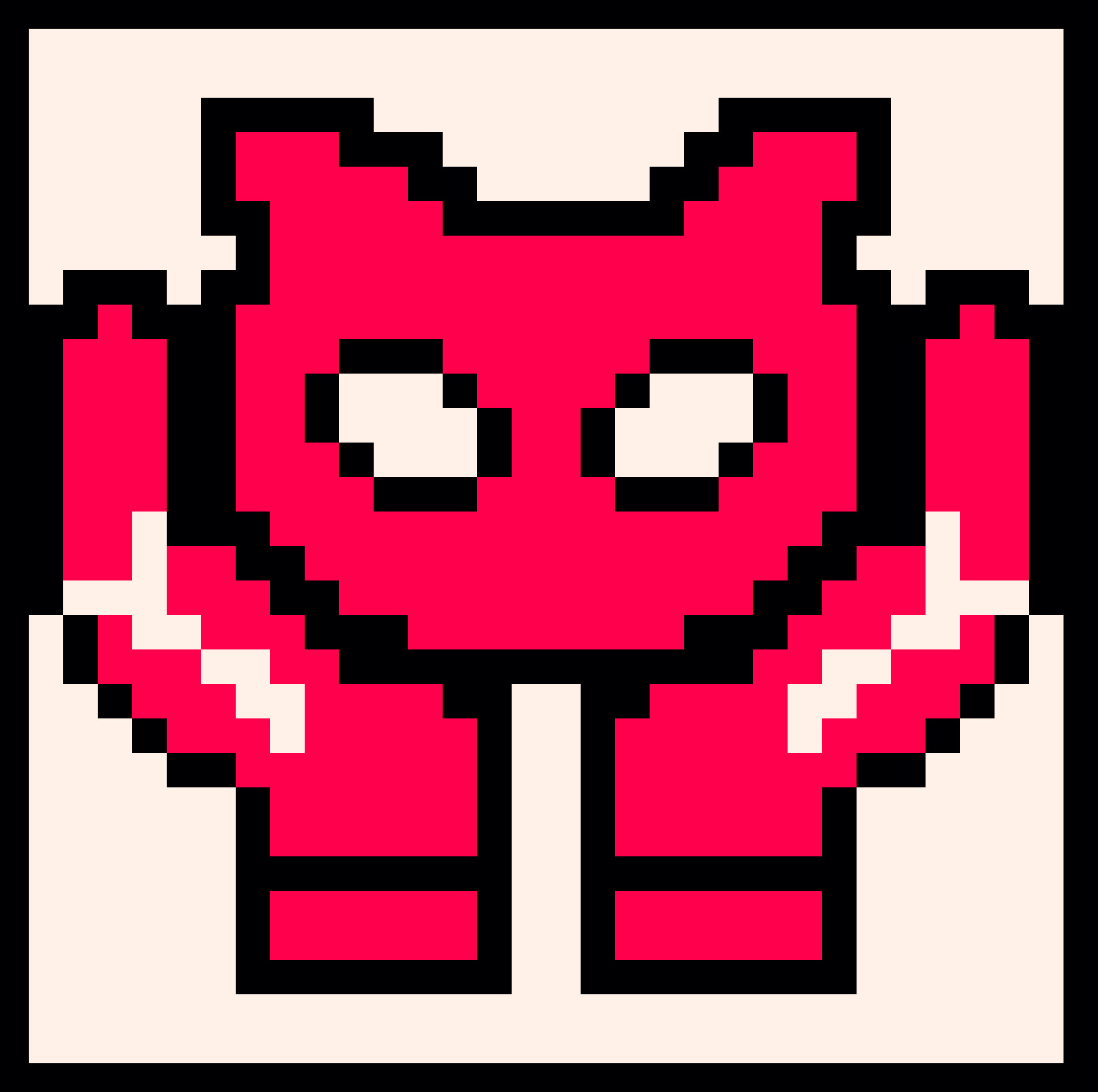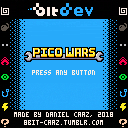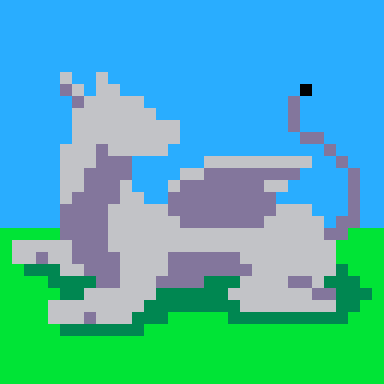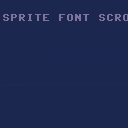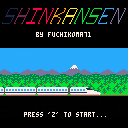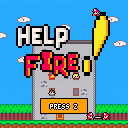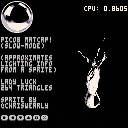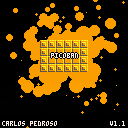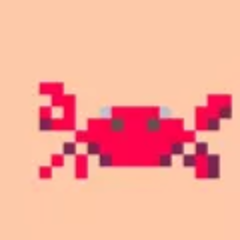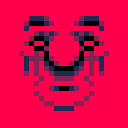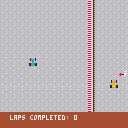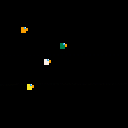A two-player juggling extravaganza!
Controls
Left player: S / F to move; Left Shift to toss!
Right player: Arrow Keys to move; N to toss!
(Controllers recommended)
Goal
The first player to drop five balls loses!
About Me
Howdy, my name is bridgs and I make games! If you enjoyed this cart, please leave a comment, I really appreciate them. And ALSO...
... if you'd like to follow me, I'm always active on Twitter!
... if making a chill lil' spider web sounds appealing, check out 8 Legs to Love!





Controls:
[ Player 1 ]
Move Left: Left Arrow
Move Right: Right Arrow
Move Up: Up Arrow
Move Down: Down Arrow
Shoot: X
[ Player 2 ]
Move Left: S
Move Right: F
Move Up: E
Move Down: D
Shoot: A
Pause Game: P
=============================================
I recently followed the Dom8verse tutorial on shooting bullets and checking collisions, which is found in Pico8zine #3. After I finished the tutorial, I kept trying to add things with the hopes of learning more about Pico-8 game development (I usually learn best when I present myself a personal challenge). One thing lead to another and I ended up creating a very simple 2-player (unfortunately it does not have a 1-player mode) robot battle game.


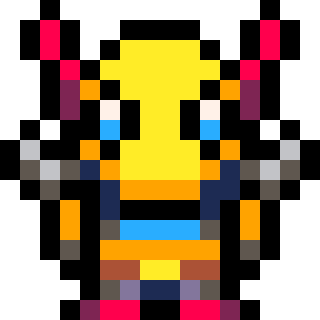

Github Link: https://github.com/torch2424/picoDeploy
Features Snippet from the README:
🖥️ Deploy to Windows, Mac, and Linux using Electron and Electron Builder
📱 Deploy to Android, iOS, and Web with all listed features using Ionic
🚀 Performant mobile builds using Crosswalk
💾 Save file (Indexedb) listener, with Pub / Sub functionality to perform actions when the save file is changed
🎮 Mobile on screen gamepad using Google Material Icons
🎮 Usb Gamepad / Xbox 360 controller / PS3 controller support using a modified pico8gamepad
💦 Splashscreen / Video to hide the Pico 8 boot screen (Not to be mistaken with Ionic mobile app splash screen)
📺 Background image or video to be displayed behind your game
⚙️ Settings screen, with support for turning sound on / off, fullscreen for desktop, customizable gamepad color, customizable background color (if not background media), Stretch the game to full resolution, and dropdown credits.
🛠️ Build System to support multiple picoDeployConfig.json files, and copied for the correct build target set in ENV variables.
♻️ Compatible with libraries like greenworks and Cordova Plugin Play Games Services. That can be plugged into a commented PlatformSdkWrapper service, which taps into the Save file listener I mentioned above.
P.S I totally started this project before version 0.1.11 which included binary exports for Windows, Mac, and Linux. However, this project still offers a great amount of functionality for deploying and building games, that binary exports do not offer currently.
Any feedback on the tool is greatly appreciated, thanks!


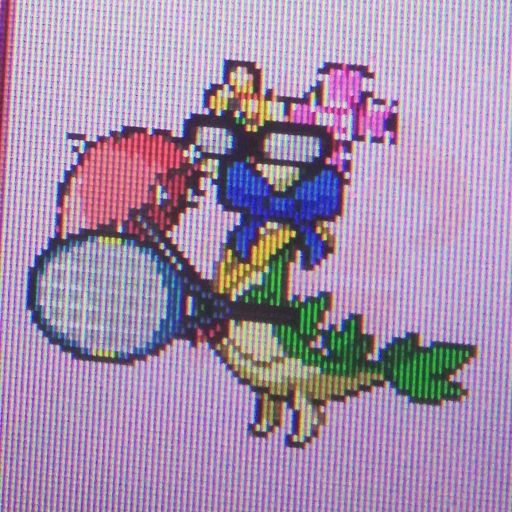
Get Dis Money Links:
Website: https://getdismoney.com/
Itch.io: https://aaronthedev.itch.io/get-dis-money
Steam: http://store.steampowered.com/app/738130/Get_Dis_Money/
Google Play: https://play.google.com/store/apps/details?id=com.teamnocomplygames.getdismoney
Source Code And Build Tools:
Source code: https://github.com/torch2424/getDisMoney-community-edition
pico8-grunt: https://github.com/TeamNoComplyGames/pico8Grunt
picoDeploy: https://www.lexaloffle.com/bbs/?tid=30920
Hello!
I just released my Pico-8 game Get Dis Money. You can use the links above to learn more about it. What is interesting, is that I was able to publish it as a full game on Steam, Google Play, and Itch.io using a build tool I made called picoDeploy. You can learn more about that above as well!
All of the code to the game's build tools is open source above, as well as this "community edition" of the game. The "community edition" is just a stripped down version of the game, but with all the main mechanics and code in place :)
I hope you enjoy! Feel free to explore any of the links I put above, and any feedback on the game is G R E A T Y L Y appreciated. Thanks!


I understand Pico-8 has a subset of the full Lua language. However, I wonder is there enough of it there to make the following book useful: https://www.amazon.com/Programming-Lua-Fourth-Roberto-Ierusalimschy/dp/8590379868/ref=pd_lpo_sbs_14_t_0?_encoding=UTF8&psc=1&refRID=JKY5ABS0S7DB70RF732Z
Does anyone have this and did it help you?
I've been able to get by picking up a smattering of lua syntax just online, but I enjoy the idea of getting a deeper look at the language. However since Pico-8 is the only platform on which I'm extensively using Lua, I want to make sure the investment would be worth it.



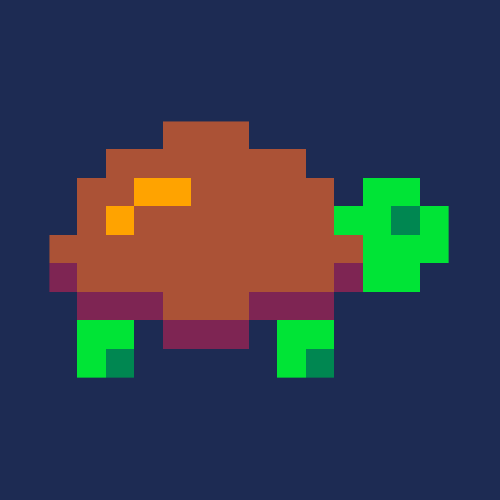


Played around with YellowAfterLife's char-functions, and ended up creating a C64-sprite-font at the same time...
I guess this has already been done a thousand times here, probably much better than this... but I just had to do my own version.
Any help with minimizing/optimizing this further would be cool.
Thanks also to Lumiette for the inspiration. :)
/ Pingo


“Shinkansen” is more of a “love letter” to the people (and railways!) of Japan than an actual game, but hopefully it is still at least mildly challenging and entertaining to play…
You are in charge of orchestrating the progressive replacement of the “conventional” railway of a “Fantasy Japan” (each game takes place on a procedurally generated island that bears little topographical resemblance to the real Land of the Rising Sun) with high-speed “bullet train” lines. Your career spans what could be considered Japan’s “golden era”, the 25 years from 1964 (historical introduction of the first Shinkansen) to 1989.
Each map features 16 cities and the inhabitants’ travel pattern is peculiar: in essence, there are commuters between any two cities identified by adjacent numbers, e.g. between “1” and “2”, between “2” and “3” etc. (“16” and “1” are considered adjacent for that purpose). At the beginning of the game, travelers follow the shortest route using the existing (conventional) rail network (grey lines).
By holding the “Z” key while moving the cursor (rounded coloured rectangle) you can connect two cities with a high-speed train line, following any available route between them (you will not be allowed to move the cursor over “forbidden” terrain). It will not replace the existing conventional railway, only run parallel to it. NB: until “Z” is released, the new route is only “in planning”.
The colour of the cursor is specific to the line, of which there can be up to five: red, green, blue, orange and purple. Once the first section of a line has been opened, it can only be “extended” (i.e. any new section must start at a terminus for that line). You can switch between lines by keeping the “X” key down when pressing the left or right arrow key.
Travelers are rational agents (some would call them AI and they’re almost certainly smarter than Sophia ;-) At the beginning of each journey, they compute the cost/benefit ratio of taking the Shinkansen: in the game, the bullet train is 5 times faster than conventional railway. By default, the cost of the ticket is JPY 5,000 per section, which is 5 times more expensive than a normal ticket. Travelers will opt to take the Shinkansen if and only if the travel time to their destination is divided by at least as much as the fare is multiplied. In other words: for the default factor of 5, only travelers whose cities of origin and destination are both serviced by the bullet train will take it.
For every section traveled by one passenger on the Shinkansen, you earn the equivalent of the fare (JPY 5,000 by default). For every section traveled by one passenger on either railway (i.e. including conventional), you must pay JPY 1,000 maintenance and operations fee. In short: if 100% travelers use the bullet train and the ticket price is JPY 5,000, you earn JPY 4,000 per passenger and per section. If fewer passengers choose the Shinkansen, your margin will shrink accordingly.
Opening one new section costs JPY 1,000,000 and you start the game with a JPY 5,000,000 budget. A new line/section can only be opened if you have enough funds available.
The yellow “post-it” note contains all the relevant information needed to play the game and plan your strategy. On the top left is the year (circled, in red). On the top right is the percentage of all ongoing journeys that use the Shinkansen. The other two numbers below are respectively the annual profit/loss (reset at the beginning of each year) and the current treasury, both in thousands of JPY.
The last section at the bottom of the “post-it” note is the current Shinkansen fare (displayed on a white/green background, my best yet pitiful attempt at reproducing an authentic JR ticket!). You change the fare (by JPY 100 increments/decrements) by holding the “X” key down while pressing the up or down arrow key. By making the necessary calculations, you can adjust it down to attract more passengers, but it will of course reduce your margin. The limits are JPY 1,000 (below which you cannot possibly break even) and JPY 5,000 (above which every traveler will choose the conventional railway over the bullet train).
This is a "sandbox" game, so you set your own objective: get 100% travelers on the Shinkansen, reach the 31,999,000 treasury limit as early as possible, use the fewest possible lines to service the whole country…
The number of travelers increases over time (by one unit every year) to reflect Japan’s booming economy. In Jan 1965, one traveler is added to the population commuting between cities “1” and “2”, in Jan 1966, it’s between “2” and “3” and so forth.
P.S. This project took longer to complete than expected and as a result, the code is rather messy... Sincere apologies to my fellow programmers with higher standards!



The city is on fire and only you can stop it. Play through 12 stages with fire to put out and civilians to save. Advance to the next level by getting rid of all the fires. Try to unlock the two hidden colors for the fighters. Once unlocked just press up at the title screen to change.
This is my first game in collection of games i will make for the pico 8. I hope you enjoy. Keep an eye out for more games soon.
--- v1.2 ---
Well I fixed a lot of little stuff that I didn't like. The collision between fighter and fire is better. A glitch that some times doesn't place something in the window is fixed. If there is no fires in the window then falling fire doesn't harm fighter. Both doors are used when rescuing civilians.
--- v1.1 ---
There is two new options in the pico menu. turn sound and flame effect on or off. also I fixed the problem with both truck appearing at the same time.


Material Capture, or "matcap" for short, is a really neat technique, and now that I've learned about it, I'm pretty surprised that it doesn't come up more often in gamedev conversations. It's great! Here's a pico8 implementation of the concept: it draws approximated realtime reflections on 3D meshes.
There are three settings that you can change while it's running:
Right/Left: Switch materials
Up/Down: Fast-mode / Slow-mode
O/X: Switch models
Fast-mode is kind of like a vertex shader in modern 3D engines (the material texture is only sampled along the edges of triangles). Slow-mode is kind of like a pixel shader (except there's no GPU to give it a speed boost)


Here is a simple function to convert a number to its hexadecimal string representation:
function num2hex(number)
local base = 16
local result = {}
local resultstr = ""
local digits = "0123456789abcdef"
local quotient = flr(number / base)
local remainder = number % base
add(result, sub(digits, remainder + 1, remainder + 1))
while (quotient > 0) do
local old = quotient
quotient /= base
quotient = flr(quotient)
remainder = old % base
add(result, sub(digits, remainder + 1, remainder + 1))
end
for i = #result, 1, -1 do
resultstr = resultstr..result[i]
end
return resultstr
end
|
Usage:
print(num2hex(255)) -- ff print(num2hex(10)) -- a print(num2hex(1050)) -- 41a |


I love the simplicity of Pico, but for quick coding like in Game Jams it's nice to have a foundation to work off of. That's why I wrote this toolkit that provides some basic functionality like debugging and physics. Has anyone else done something like this before? Should I add anything else?
Thanks!



Converting shr() safely to simple math:
shr(v, 16) ==> v * 0x.0001 shr(v, 15) ==> v * 0x.0002 ... shr(v, 2) ==> v * 0x.4000 (or 0.25) shr(v, 1) ==> v * 0x.8000 (or 0.5) |
Multiplying by the fraction avoids a hazard where a negative number can go to 0 when dividing by numbers greater than 1, which destroys the sign-extending upper bits you expect to keep with shr().
It also allows shifts up to 16, whereas dividing only allows shifts up to 14. This is because PICO-8 can't represent any powers of 2 larger then 16384.
Similarly, because it is safe to divide by a fractional number less than 1, you can use the same idea to shift left up to 16 bits:
shl(v, 16) ==> v / 0x.0001 shl(v, 15) ==> v / 0x.0002 ... shl(v, 2) ==> v / 0x.4000 (or 0.25) shl(v, 1) ==> v / 0x.8000 (or 0.5) |
In this case, it's down to style or the need to shift by more than 14. Unlike dividing, multiplying by values greater than 1 is safe, so you can also obviously just convert shl(v,2) to v*4. PICO-8 performs divides as fast as multiplies, so performance is the same either way.
Basically, your safe bet is always to use the fractional power of two, whether dividing or multiplying. If you want to be sure, start your constant with "0x." and you'll always get it the right way around. :)
The reason some of us want to do this, rather than the more-intuitive shift calls, is that it saves one token per shift. That can add up quickly in a program heavy with binary math.








 6 comments
6 comments
